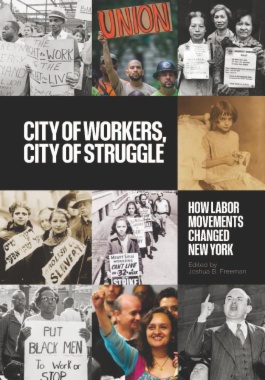From the founding of New Amsterdam until today, working people have helped create and re-create the City of New York through their struggles. Starting with artisans and slaves in colonial New York and ranging all the way to twenty-first-century gig-economy workers, this book tells the story of New York’s labor history anew.
City of Workers, City of Struggle brings together essays by leading historians of New York and a wealth of illustrations, offering rich descriptions of work, daily life, and political struggle. It recounts how workers have developed formal and informal groups not only to advance their own interests but also to pursue a vision of what the city should be like and whom it should be for. The book goes beyond the largely white, male wage workers in mainstream labor organizations who have dominated the history of labor movements to look at enslaved people, indentured servants, domestic workers, sex workers, day laborers, and others who have had to fight not only their masters and employers but also labor groups that often excluded them. Through their stories—how they fought for inclusion or developed their own ways to advance—it recenters labor history for contemporary struggles. City of Workers, City of Struggle offers the definitive account of the four-hundred-year history of efforts by New York workers to improve their lives and their communities.
In association with the exhibition City of Workers, City of Struggle: How Labor Movements Changed New York at the Museum of the City of New York
- Table of Contents
- Director’s Foreword, by Whitney W. Donhauser
- Introduction: Workers’ Movements, Workers’ Struggles in New York, by Sarah M. Henry
- Workers in the City of Commerce: 1624–1898
- 1. Artisan Labor in Colonial New York and the New Republic, by Simon Middleton
- 2. Slave Labor in New York, by Leslie M. Harris
- 3. Sailors Ashore in New York’s Sailortown, by Johnathan Thayer
- 4. Housework and Homework in 19th-Century New York City, by Elizabeth Blackmar
- 5. Victims, B’hoys, Foreigners, Slave-Drivers, and Despots: Picturing Work, Workers, and Activism in 19th-Century New York, by Joshua Brown
- Union City: 1898–1975
- 6. The Needle Trades and the Uprising of Women Workers: 1905–1919, by Annelise Orleck
- 7. Sex Work and the Underground Economy, by LaShawn Harris
- 8. Here Comes the CIO, by Joshua B. Freeman
- 9. Puerto Rican Workers and the Struggle for Decent Lives in New York City: 1910s–1970s, by Aldo A. Lauria-Santiago
- 10. Labor and the Fight for Racial Equality, by Martha Biondi
- 11. Public Workers, by William A. Herbert
- Crisis and Transformation: 1975– 2018
- 12. The Fiscal Crisis and Union Decline, by Kim Phillips-Fein
- 13. Health-care Workers and Union Power, by Brian Greenberg
- 14. Chinatown, the Garment and Restaurant Industries, and Labor, by Kenneth J. Guest and Margaret M. Chin
- 15. Domestic Workers, by Premilla Nadasen
- 16. New Forms of Struggle: The “Alt-labor” Movement in New York City, by Ruth Milkman
- Conclusion: How Labor Shaped New York and New York Shaped Labor, by Joshua B. Freeman
- For Further Reading
- Index
- Image Credits

